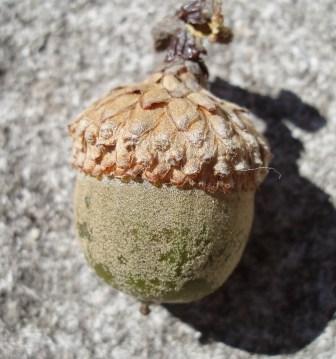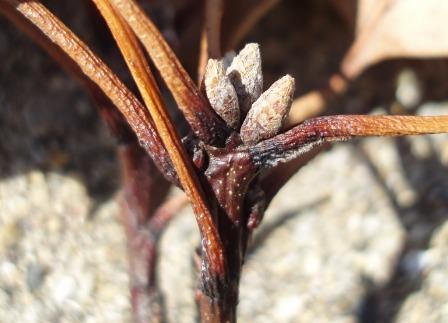by Carl Strang
In a post more than a year ago I made a preliminary case for the possibility that a group of young oaks on a savanna ridge top in Mayslake Forest Preserve may be Hill’s oaks. There I discussed leaf and bud shapes, which were consistent with Hill’s, but I needed acorns to conclude the case. This year a couple of the trees have produced acorns.
Furthermore, a new paper came out by Andrew Hipp, one of the co-authors of the publication I discussed in the previous post. The new paper, available on line here, goes into detail to separate Hill’s, black and scarlet oaks (the complete reference is: Hipp, Andrew L. 2010. Hill’s oak: the taxonomy and dynamics of a western Great Lakes endemic. Arnoldia 67(4):2-14). The following account is drawn from that paper.
Hill’s oak, Quercus ellipsoidalis, also known as northern pin oak, was distinguished from scarlet oak (Q. coccinea) in 1899 by Ernest J. Hill, who studied populations in Cook County, Illinois. Hipp and Jaime Weber surveyed the genetics of these trees and concluded that Hill’s oaks and scarlet oaks are distinct, though they are one another’s closest relatives. Except for a few individuals introduced by people from farther south, scarlet oaks do not occur in northeast Illinois (though there may be some in northwest Indiana). Hill’s oaks and scarlet oaks apparently separate according to geology, with the former inhabiting savannas on dry or well drained soils that developed from glacial deposits. Hill’s oaks are distinct from other members of the black oak group, though they sometimes hybridize with black oaks (Q. velutina). Their habitat, buds and leaves distinguish them from all other species except black oaks.
The biggest difference between Hill’s and black oaks is in the acorns. Black oak acorns have caps in which the scales are fuzzy, and loose at the tips, as shown by this example from an enormous black oak growing in Culver, Indiana.
In Hill’s oak the caps are shiny and their scales are tight. This description fits acorns from the ridge top trees at Mayslake.
The inside of the black oak acorn cap is fuzzy, while that of Hill’s is smooth. Photos in Hipp’s paper illustrate this, and the Culver and Mayslake acorn caps separate accordingly. So it seems that this is one question I can shift from my mental file of mysteries unresolved to that of inquiries concluded.





